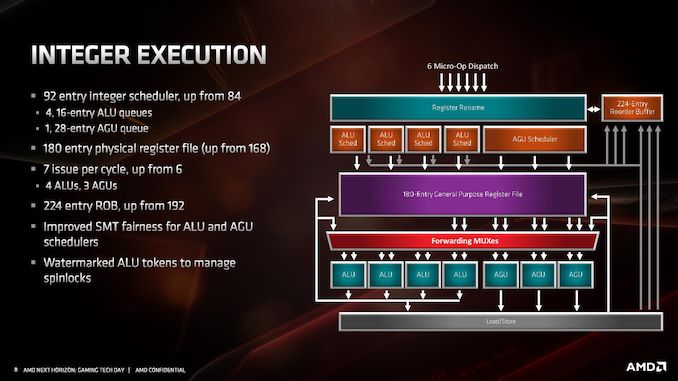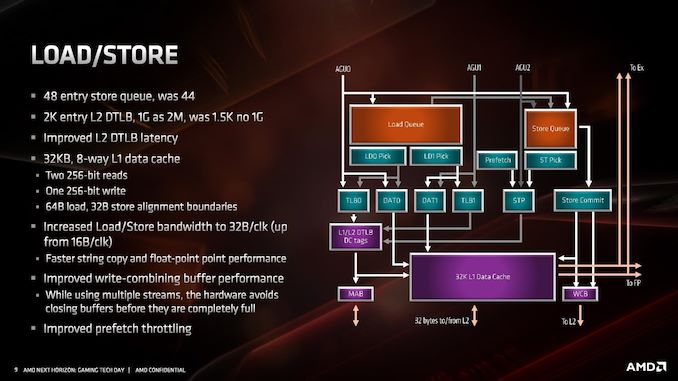AMD Zen 2 Microarchitecture Analysis: Ryzen 3000 and EPYC Rome
by Dr. Ian Cutress on June 10, 2019 7:22 PM EST- Posted in
- CPUs
- AMD
- Ryzen
- EPYC
- Infinity Fabric
- PCIe 4.0
- Zen 2
- Rome
- Ryzen 3000
- Ryzen 3rd Gen
Integer Units, Load and Store
The integer unit schedulers can accept up to six micro-ops per cycle, which feed into the 224-entry reorder buffer (up from 192). The Integer unit technically has seven execution ports, comprised of four ALUs (arithmetic logic units) and three AGUs (address generation units).
The schedulers comprise of four 16-entry ALU queues and one 28-entry AGU queue, although the AGU unit can feed 3 micro-ops per cycle into the register file. The AGU queue has increased in size based on AMD’s simulations of instruction distributions in common software. These queues feed into the 180-entry general purpose register file (up from 168), but also keep track of specific ALU operations to prevent potential halting operations.
The three AGUs feed into the load/store unit that can support two 256-bit reads and one 256-bit write per cycle. Not all the three AGUs are equal, judging by the diagram above: AGU2 can only manage stores, whereas AGU0 and AGU1 can do both loads and stores.
The store queue has increased from 44 to 48 entries, and the TLBs for the data cache have also increased. The key metric here though is the load/store bandwidth, as the core can now support 32 bytes per clock, up from 16.












216 Comments
View All Comments
Korguz - Monday, June 17, 2019 - link
im glad im not the only one that sees this...Qasar - Monday, June 17, 2019 - link
korguz, you aren't the only one that sees it.Xyler94, i dont hate intel.. but i am sick of what they have done so far to the cpu industry, sticking the mainstream with quad cores for how many years ? i would of loved to get a 6 or 8 core intel chip, but the cost of the platform, made it out of my reach. the little performance gains year over year, come on, thats the best intel can do with all the money they have ?? and the constant lies about 10nm.... then Zen is released and what was it, less then 2 months later, intel all of a sudden has more then 4 cores for the mainstream, and even more cores for the HEDT ? my next upgrade at this point, looks to be zen 2.. but i am waiting till the 7th, to read the reviews. hstewart does glorify intel any chance he can, and it just looks so stupid, cause some one calls him out on it.. and he seems to pretty much vanish from that convo
HStewart - Thursday, June 13, 2019 - link
Notice that I mention unless they change it from dual 128 bit.Targon - Thursday, June 13, 2019 - link
Socket AM4 is limited to a dual-channel memory controller, because you need more pins to add more memory channels. The same applies to the number of PCI Express lanes as well. The only way around this would be to use one of the abilities of Gen-Z where the CPU would just talk to the Gen-Z bus, at which point, dedicated pins for memory and PCI Express could be replaced by a very wide and fast connection to the system bus/fabric. Since that would require a new motherboard and for the CPU to be designed around it, why bother with socket AM4 at that point?Korguz - Thursday, June 13, 2019 - link
why bother?? um upgrade ability ? maybe not quite needed ? the things you suggest, sound like they would be a little expensive to implement. if you need more memory bandwidth and pcie lanes.. grab a TR board and a lower end cpu....austinsguitar - Monday, June 10, 2019 - link
Thank you Ian for this write up. :)megapleb - Monday, June 10, 2019 - link
Why does the 3600X have power consumption of 95W, and the 3700X, with two more cores, four more threads, and the same frequency max, consume only 65W? I'm guessing those two got switched around?anonomouse - Monday, June 10, 2019 - link
higher sustained base clock drives up the tdpmegapleb - Monday, June 10, 2019 - link
200Mhz extra base increases power consumption by 46%? I would have though max power consumption would be all cores operating at maximum frequency so the base would have nothing to do with it?scineram - Tuesday, June 11, 2019 - link
Nobody said anything about power consumption.